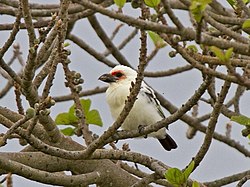| Chaplin's barbet | |
|---|---|
 | |
| Scientific classification | |
| Kingdom: | Animalia |
| Phylum: | Chordata |
| Class: | Aves |
| Order: | Piciformes |
| Family: | Lybiidae |
| Genus: | Lybius |
| Species: | L. chaplini |
| Binomial name | |
| Lybius chaplini Clarke, 1920 | |
Chaplin's barbet (Lybius chaplini) or the Zambian barbet, is a bird species in the family Lybiidae, which was until recently united with the other barbets in the Capitonidae. This bird was named in honor of Sir Francis Drummond Percy Chaplin, a former colonial governor. The species was renamed to emphasize its status as Zambia's only true endemic bird species. It is endemic to South Central Zambia and is restricted to the area between the Upper Kafue River to Kabanga in the Kalomo District. [2] Its natural habitats are moist savanna and arable land. It is threatened by habitat loss. It was formerly classified as a Near Threatened species by the IUCN. But new research has shown it to be rarer than it was believed. Consequently, it is uplisted to Vulnerable status in 2008. [1]
